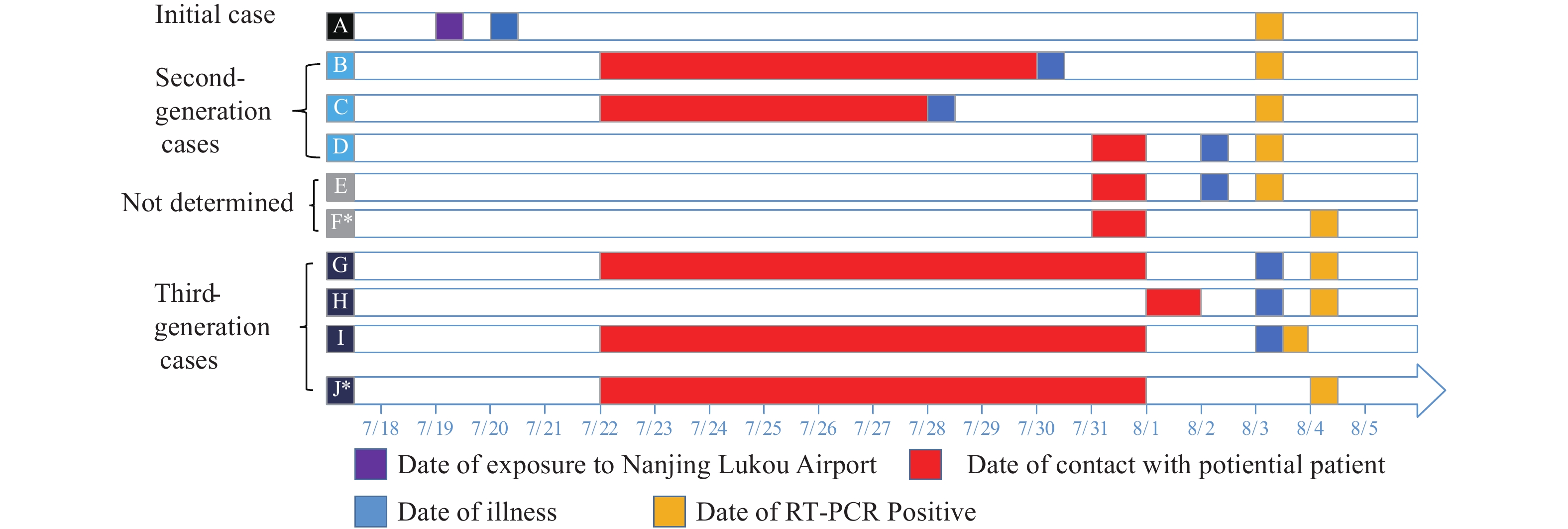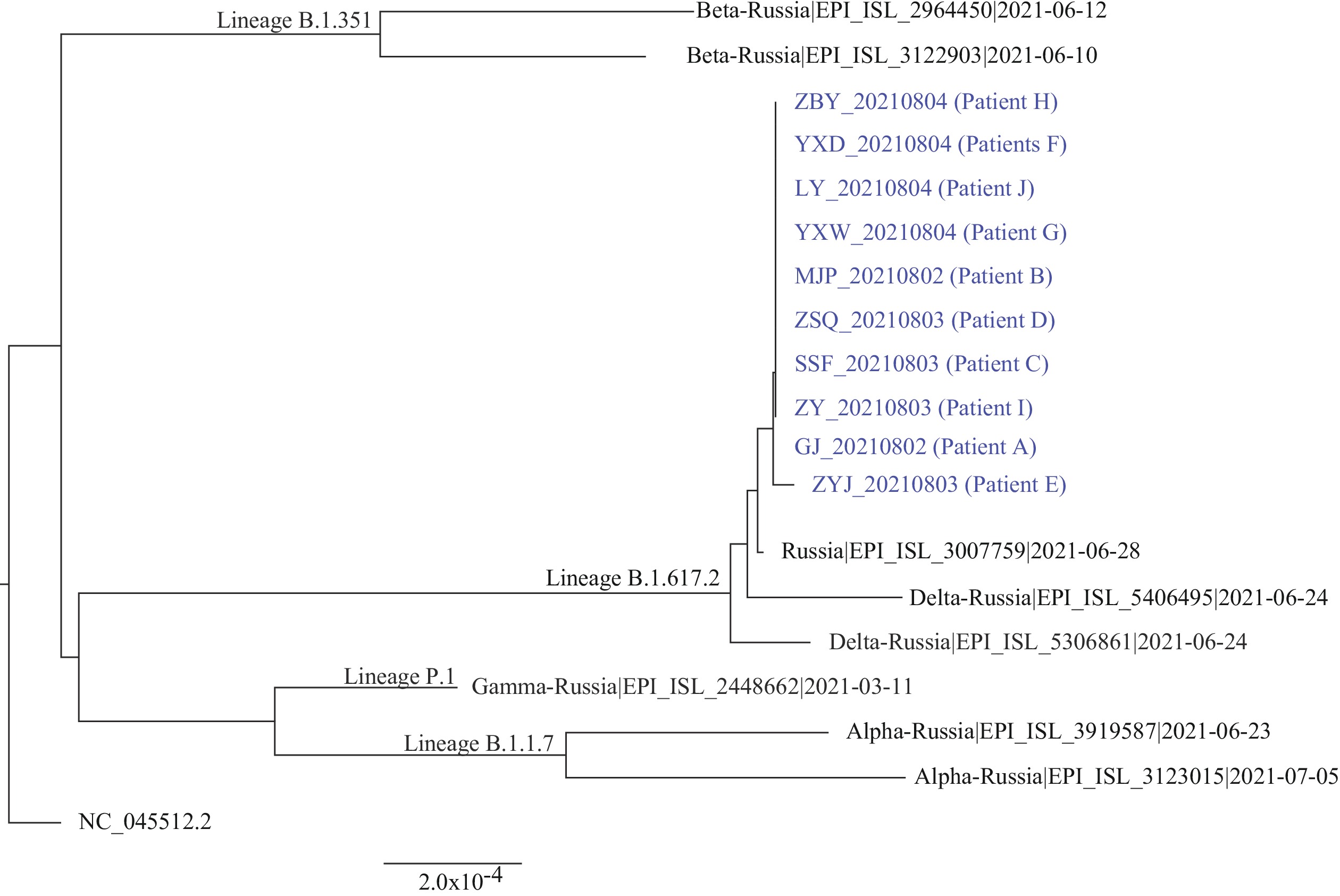-
As of September 18, 2021, more than 200 million people were confirmed as coronavirus disease 2019 (COVID-19) cases worldwide, including more than 4 million deaths, reported by the World Health Organization (WHO) (1). The Delta variant of severe acute respiratory syndrome coronavirus 2 (SARS-CoV-2) was first identified in India in October 2020 (2) and had become the dominant variant globally. There is evidence showing that this variant is significantly more infectious (3). On July 20, 2021, Nanjing City reported 9 symptomatic and 2 asymptomatic cases of COVID-19, who were all cleaning staff of Nanjing Lukou Airport and detected by the latest weekly SARS-CoV-2 nucleic acid tests. In the next 10 days, more than 10 cities reported COVID-19 cases related to Nanjing Lukou Airport. On August 3, 2021, Yantai City reported 2 confirmed cases of COVID-19, who were both staff members of a cosmetic hospital and detected by the latest routine COVID-19 nucleic acid test, and finally led to a cluster of 10 cases.
-
We found 10 cases in this cluster, of which 8 were confirmed cases and 2 were asymptomatic cases (Table 1). Their median age was 28.5 years, and 4 were male. Overall, 9 of these cases worked in the operations department or aesthetic design department. The first 2 cases were found by routine COVID-19 nucleic acid test, while the rest were detected by close contact tracking and screening; these cases were reported on August 3 and 4, respectively. The most commonly reported symptoms were fever, cough, and pharyngalgia. Each of them was given 2 doses of SARS-CoV-2 inactivated vaccines, and vaccination was mainly completed in February, May, and June. After the first 2 cases were found by routine COVID-19 nucleic acid test, more than 1,000 people were isolated and tested as close contacts, and only 8 of them tested positive, all staff members of this cosmetic hospital. SARS-CoV-2 vaccination rate of close contacts in this cosmetic hospital (87.7%, 263/300) was higher than outside the cosmetic hospital (68.6%, 717/1,045), (χ2=42.798, P
<0.001). Patient Age (years) Gender Position Case type Discovery pathway Symptoms* Month of complete the whole process of SARS-CoV-2 vaccines A 39 Female Hospital director Confirmed case Routine COVID-19 nucleic acid test 2,4,8 June B 28 Male Director of plastic surgery marketing department Confirmed case Regular COVID-19 nucleic acid test 2,3,5,9,10 May C 29 Male Director of aesthetic design department Confirmed case Close contacts tracking and screening 1,4,7 February D 38 Female Staff of aesthetic design department Confirmed case Close contacts tracking and screening 4 February E 26 Female Assistant of the hospital deputy director Confirmed case Close contacts tracking and screening 1,2,5,6,7 May F 33 Male Director of receptionists Asymptomatic case Close contacts tracking and screening − June G 26 Female Assistant of operating room physician Confirmed case Close contacts tracking and screening 1,4,5 May H 25 Male Staff of electricity-network department Confirmed case Close contacts tracking and screening 1,4,7 May I 28 Female Staff of aesthetic design department Confirmed case Close contacts tracking and screening 1,4 May J 33 Female Staff of aesthetic design department Asymptomatic case Close contacts tracking and screening − May Abbreviations: COVID-19=coronavirus disease 2019; SARS-CoV-2=severe acute respiratory syndrome coronavirus 2; CT=computed tomography.
* 1=fever; 2=cough; 3=expectoration; 4=pharyngalgia; 5=headache; 6=myalgia; 7=weakness; 8=vomiting; 9=ageusia; 10=CT findings of ground-glass opacities; − represented no symptom.Table 1. Clinical characteristics and vaccination history of COVID-19 patients.
The cosmetic hospital has 22 departments and 304 staff members. The index COVID-19 cases in the cosmetic hospital occurred in a 39-year-old female (Patient A), the director of the hospital, and a 28-year-old male (Patient B), the director of the plastic surgery marketing department. They were detected during the monthly SARS-CoV-2 nucleic acid test on August 2, 2021 and were diagnosed as confirmed cases of symptomatic COVID-19 on August 3.
The field epidemiological investigation found that Patient A flew to Guilin from Yantai on July 19, 2021, with a stopover of one hour at Nanjing Lukou Airport (the suspected source of COVID-19 outbreak in Nanjing City at that time), while Patient B did not leave Yantai during the latest 14 days. Patient A did not drink, eat, or have close contact with the airport staff, except going to the bathroom during the stop according to her description, but she experienced a cough the next day. She went back to Yantai on July 22 and took an intravenous drip and some cold pills during the next several days. Furthermore, after returning from Guilin, Patient A attended several morning briefings with more than 10 aesthetic design department staff members (including Patients B–F, I, and J). On July 31, Patient A organized a team-building activity for the cosmetic hospital staff and participated in a 10-person dinner (including Patients B, C, E, and F). Patient B had frequent contact with Patient A during work and coughed on July 30.
A total of 117 close contacts of Patient A were traced and quarantined, who were sampled and tested on the 1st, 3rd, 5th, 7th, 12th, and 13th day of centralized isolation. Overall, 3 confirmed cases and 1 asymptomatic case, Patients C–F, were identified during August 3 to 4 among these close contacts. In the same way, local CDCs traced and tested close contacts of Patients B–F, and 3 confirmed cases and 1 asymptomatic case, Patients G–J, were detected. In total, 10 confirmed or asymptomatic COVID-19 cases, Patients A–J, were identified in this cluster (Figure 1 and Table 1), who were all staff of the cosmetic hospital, and none of them had a history of travel to high risk areas 14 days before the onset of illness except Patient A.
 Figure 1.
Figure 1.Cluster of COVID-19 cases associated with a cosmetic hospital in Yantai, Shandong province, China, 2021.
Abbreviations: COVID-19=coronavirus disease 2019; RT-PCR=reverse transcription-polymerase chain reaction. * means asymptomatic case.Among the later identified 8 cases, Patient C, the director of aesthetic design department, and Patient D, a staff of aesthetic design department, also had frequent contact with Patient A during work. Patient B and C had frequent contact with many staff members, including Patients E, F, I, and J. Patient G only had contact with Patient B during work among the other 9 cases, while Patient H, a new employee in the cosmetic hospital, sat next to Patient B in the office. Furthermore, Patients B, E, F, and H were in the same office, and Patients C, I, and J often had lunch together.
Further investigation, including case interviews and examining the surveillance video, found that 9 of the 10 cases (except Patient G) were administrative staff, had separate office areas, and did not use the elevator for customers. Though most of the cosmetic hospital staff did not wear masks when they had contact with each other, they did wear masks strictly when contacting customers and after work. The usual work time of these 10 cases were 08∶00 to 21∶00, so they had little time to accompany their families.
From August 3 to 8, more than 30,000 people from the community where the cases resided and worked were screened with polymerase chain reaction (PCR) testing, and all Yantai City residents were eventually tested. No additional cases were found in the 6.5 million citizens.
Compared with the Wuhan reference strain (NC_045512) sequence, the COVID-19 genome sequence in Yantai cosmetic hospital belonged to the VOC/Delta variant (B.1.617.2 evolution branch). The 10 whole genome sequences shared 35 nucleotide mutation sites and 9 nucleotide deletion sites. On this basis, the genome sequence of Patient E added a mutation site (g27990t), and the homology between sequences was greater than 99.99%. It was located in the same branch and belonged to the same transmission chain in phylogenetic analysis. In the comparative analysis of the GISAID database (https://platform.epicov.org/), there were 34 nucleotide mutation sites consistent with the above sequence in the sample sequence collected by Russia on June 28, 2021, which had the parental sequence characteristics of the epidemic sequence, indicating that the epidemic may have been caused by overseas transmission (Figure 2).
 Figure 2.
Figure 2.Phylogenetic tree based on the SARS-CoV-2 whole genome sequences in a cosmetic hospital of Yantai, 2021.
Notes: The Yantai cosmetic hospital VOC/Delta variant is marked in blue.The Wuhan reference strain (NC_045512.2) and other variants are marked in black. Abbreviation: SARS-CoV-2=severe acute respiratory syndrome coronavirus 2.According to the field epidemiological investigation and whole genome sequence traceability analysis, Patient A was likely the source of this COVID-19 cluster, Patients B–D were infected by Patient A, Patients G and H were infected by Patient B, and Patients I and J were infected by Patient C. The source of infection for Patients E and F could not be determined conclusively and may be due to transmission from Patients A–C. Therefore, there were 3 generations in this cluster.
-
This outbreak was likely a cluster infection related to Lukou Airport in Nanjing and was confined to a limited area — all cases occurred in the cosmetic hospital and did not spread outside this cosmetic hospital, indicating that the strategies used in Yantai City, including mass testing, active case finding, close contact and general contacts screening, and community management, were highly effective. Compared with the cluster of COVID-19 cases in other cities, which were also related to Lukou Airport in Nanjing, this cluster in Yantai was limited both in terms of infection scope and number of people infected for several reasons. First, SARS-CoV-2 vaccination rate in the cosmetic hospital and close contacts outside the hospital were higher than in other cities (4-5), as the inactivated SARS-CoV-2 vaccines against the Delta and other variant infections were still effective and protected other close contacts from infection (6-7). Second, the surveillance video confirmed that masks were worn regularly in the workplace. Because wearing masks was among the non-pharmaceutical intervention measures that could be effectively implemented at a minimal cost and without dramatically disrupting social practices (8), face mask use and other personal protections should be continued. Third, the surveillance video showed that 9 cases in this cluster worked at the auxiliary building and they seldom used elevators or other public spaces, so reducing exposure to contaminated environment can also protect other staff members from being infected.
Recommendations have been made to strengthen investigations of personnel coming to Shandong from the medium and high-risk areas and the prevention of nosocomial COVID-19 infections to prevent transmission at these medical institutions.
HTML
| Citation: |



 Download:
Download:




